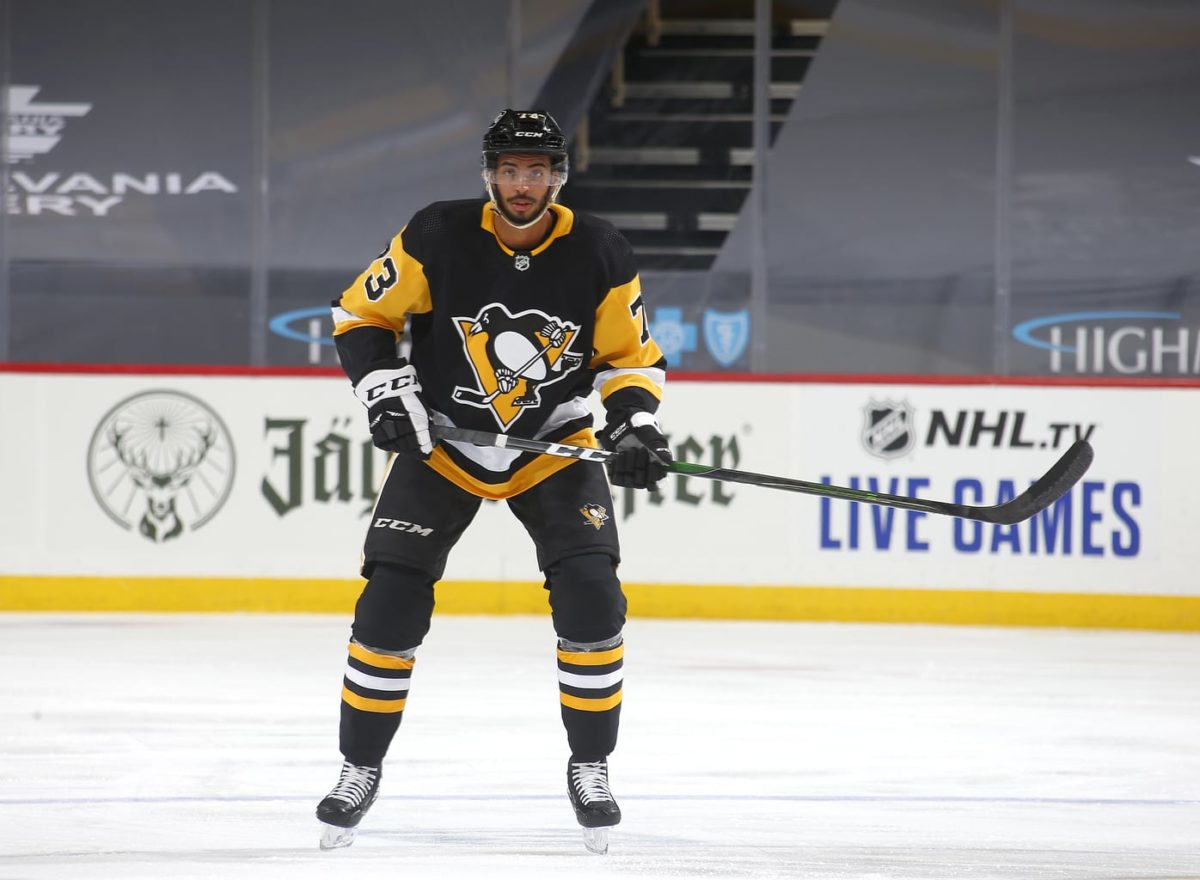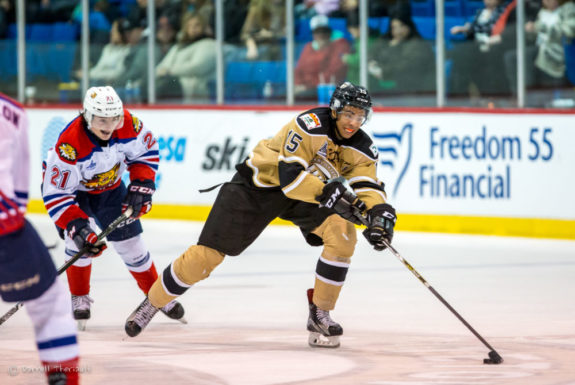The prevailing paradigm of letting prospects marinate in the minors until they’ve ripened is a double-edged sword. On the one hand, giving a young defenseman (such as Pierre-Olivier Joseph of the Pittsburgh Penguins) ice-time facing lesser competition offers them the opportunity to gradually adjust to the rigors of professional hockey. They can develop the skills that will safeguard them against NHL competition at their own pace, and find their niche in the organizational hierarchy. However, adopting a sink-or-swim approach has its benefits. It unambiguously demonstrates whether a player thrives under pressure or wilts under the weight of responsibility. If done correctly, the prospect finds new depths to their play and discovers what they’re truly capable of at the highest level.
Luckily, Joseph has shown promising glimpses of talent, and elevating him higher in the lineup does not resemble aloof carelessness where prospect development is concerned. He’s asserted himself in the professional sphere in the American Hockey League (AHL), and held his own in limited NHL spot duty, compiling a compelling case for increased responsibilities on the Penguins’ blueline. That’s not to say he should instantly be force-fed top-pair minutes against the Connor McDavids of the world on a nightly basis, but giving him some leash in attacking situations will cultivate the budding offensive creativity he’s demonstrated thus far. Who knows, the Penguins may inadvertently unearth the next Kris Letang and critically reenergize an aging core.
Offense From the Blueline
Although Joseph has not posted enormous point totals at any point of his career (his tenure in junior included), he possesses the ability to reliably fire off a crisp first pass and locate the open man for a scoring chance. When given free rein to roam the ice, he demonstrates an eagerness to orchestrate the attack to his liking. Despite participating in only 16 games at the NHL level last season, his rate statistics hint at a burgeoning offensive talent itching for a greater opportunity.
Even-Strength Exploits
Even after a cumulative 245 minutes at five-on-five for the Penguins last season, Joseph’s results pointed to a debutant worthy of a bigger role on the blue line. Although simply looking at a player’s surface-level output (think goals, assists, points, etc.) ignores the value of incorporating underlying statistics into one’s analysis, it benefits us to contextualize how he fared compared to his positional peers during his first stretch of extended NHL time.

Among NHL defensemen who played a minimum of 100 minutes at five-on-five, The Hockey Writers’ 80th-ranked prospect produced the seventh-highest rate of primary assists (0.73) – awarded to the last passer before a goal is scored – per 60 minutes, ranking higher Cale Makar, John Carlson, and Adam Fox, among others.
Primary assists are generally more indicative of future production as the player is more likely to have been directly involved in the goal, as opposed to secondary assists where an assist may simply be a case of happenstance, rather than any tangible impact on the outcome of the play. Looking at micro-stat data is more informative (shot assists, high-danger passes) but Joseph’s small sample of games, unfortunately, means that there was very little tracking of his performance in those departments, so we’re stuck with primary assists.
Aside from his playmaking, Joseph impressed with his cavalier rushes into the offensive zone, lacking any timidness in challenging the goaltender. The 2017 first-rounder tied with perennial Norris Trophy candidate Victor Hedman for a spot in the top-30 of the most productive shot-generating defensemen, launching 6.1 shots per 60 minutes. As his first NHL goal illustrates, Joseph has the tools to let loose when necessary.
Beyond his offensive production, Joseph’s powerful skating stride allows him to deftly evade oncoming forecheckers and causes them to take last-ditch penalties to impede his progress, often in vain. He drew penalties to the tune of 0.73 per 60 minutes, the 15th highest rate among NHL defensemen last season. Harnessing the awareness that you can either manufacture a prime scoring chance or put your team on the man-advantage positions him as a blossoming offensive force. For a team that possesses as prolific a power play as the Penguins (23.7% – fourth in the NHL last season), being able to consistently get on the man-advantage is a valuable skill in and of itself.
Naturally, one hopes that the team’s most coveted defensive prospect posts positive results in their limited usage, but those appearances are just that; limited. Joseph only featured in 16 total NHL games last season and was used sparingly in a bottom-pair role at even-strength, playing just over 16 minutes a night at five-on-five. Yes, his sample size is minuscule, and it’s foolish to draw conclusions from a case that is extremely susceptible to just plain old luck, but there’s true potential to be mined. In the end, more ice-time may show that he is ultimately not suited for a more demanding role, and he’ll be relegated to the margins of the lineup. In any case, it pays to be skeptical.
Power Play Production
Due to Joseph’s virtually non-existent power play resume with the Penguins (a scant 24 seconds per game on the man-advantage) this section is limited to his performance for Wilkes-Barre/Scranton in the AHL. The Laval-native finished with seven power-play assists, tying for ninth among all AHL defensemen despite playing five fewer games than most of those who eclipsed his season total.
It follows that given a more talented band of linemates on one of the Penguins’ top units, Joseph could rapidly boost his counting stats. However, the continued presence of Kris Letang as the Penguins’ eternal power play staple severely limits his potential for upward mobility. If Letang misses any extended period of time, Joseph may be the fortuitous benefactor of more frequent deployment in a plush role.
Joseph’s Defensive Results
As hockey is not restricted to the offensive zone, Joseph’s impact in the defensive aspects should be analyzed when considering his application for more ice-time. Relying on micro-stats is often an erroneous endeavor, as a player’s excellence in one isolated facet of a hockey game does not necessarily translate to increasing their overall effectiveness. Even still, the galavanting blueliner efficiently utilizes his stick as a defensive tool, halting opposing attacks and manufacturing counterattacks when appropriate. Among 257 qualified NHL defensemen who exceeded the minutes threshold last season, he ranked 61st in the number of takeaways he completed per 60 minutes (0.98).

Broadening our scope, we can glean a more accurate interpretation of Joseph’s overall defensive impact from the rate at which the Penguins concede shots and scoring chances when he is on the ice. Using the same filter from the previous section (at least 100 minutes at five-on-five), the slender rearguard generally grades out as a top-six defenseman with regards to his ability to prevent dangerous chances against. In terms of Fenwick against – a fancy term for unblocked shots – per 60 minutes (FA/60), Joseph ranked 73rd at five-on-five and was 93rd in scoring chances conceded per 60 minutes (SCA/60). At first glance, those are decent results, exemplary even. However, expected goals against (xGA) accounts for the quality of those chances and paints a more accurate depiction of where said chances originate.
Harkening back to that group of 257 defensemen, Joseph finds himself 207th in xGA/60 at five-on-five, which is more worrisome than when simply looking at the number of shots or chances conceded. Those results indicate that defensive growing pains are likely, but not egregious enough that they cannot be overcome. It’s important to remember that he is not being brought in for his defensive acumen, especially when two of the team’s defensemen (Marcus Pettersson and Chad Ruhwedel) rank within the top-20 of those same metrics. If anything, they can be deployed in such a fashion that insulates Joseph’s youthful exuberance and protects the team from surrendering an avalanche of debilitating chances.
You May Also Like:
- Penguins’ Kyle Dubas Already on the Hot Seat This Season
- 4 Things Patrick Roy Can Learn From Jon Cooper & Mike Sullivan
- Pittsburgh Penguins’ 10 Best Defensemen in Team History
- Hockey History – the NHL “Second Six”
- Penguins’ Projected 2024-25 Opening Night Lineup
As with the evaluation of his offensive results, the sample size is simply too small to make any definitive statements about Joseph’s place in an NHL defensive group. Arguments can be made to place player’s in more favorable situations where they can flourish as I have done up to this point, but we could simply be obsessing over volatile variance in the short term. Joseph may succeed and he may not, but a conclusion cannot be drawn until he consistently features in the Penguins’ lineup.
Jumpstarting Joseph’s NHL Journey
There are countless examples of highly-regarded prospects thrown to the wolves and floundering (the Toronto Maple Leafs‘ handling of a teenage Luke Schenn springs to mind), but Joseph has shown he has the potential to breathe new life into the Penguins’ lineup. His promotion supplies a fresh offensive catalyst and lessens the productive burden shouldered by Pittsburgh’s stars. If there’s one thing that conservative NHL management could stand to change, it’s the overabundant apprehension with which they regard daring prospects and their propensity to exhibit a steep learning curve. What’s the point in trotting out someone with a limited ceiling who plays it safe, when you’ve got a player bursting with potential shackled due to archaic notions of player development? Much to ponder Pittsburgh, much to ponder.
All statistics courtesy of Natural Stat Trick unless indicated otherwise.